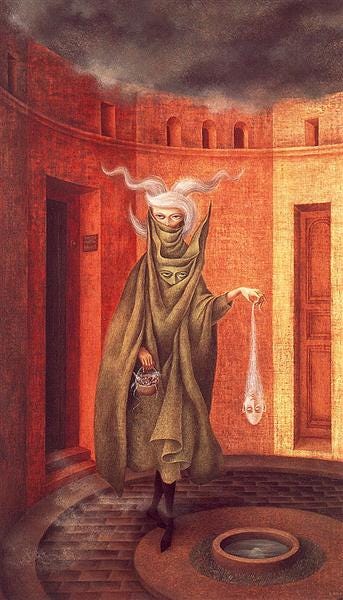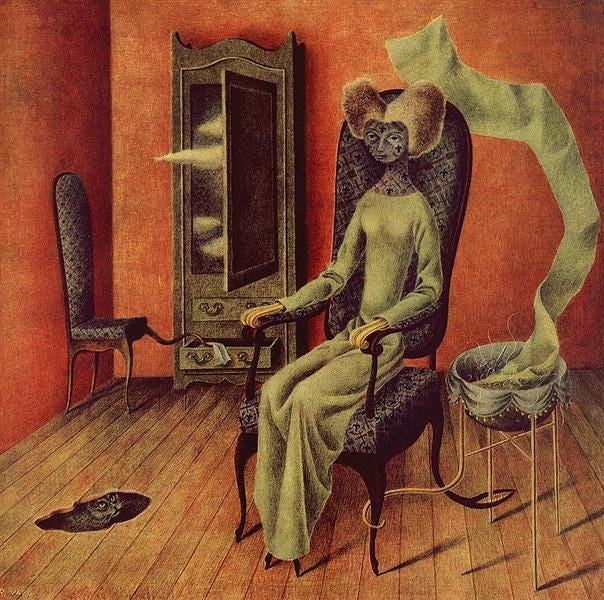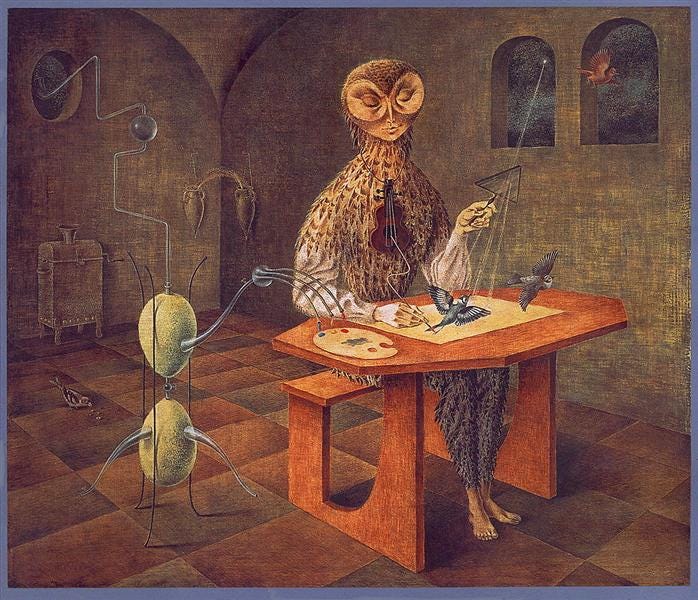Resources
Here's How You Can Help Migrant Communities In LA
Red cards, hotlines, and legal tips: How to respond to ICE raids in Los Angeles
Worried about ICE raids? Here’s what Southern California employers, employees can do
Urge Congress to Reject Immoral Reconciliation Bill
7 Meaningful Ways to Support The LGBTQIA+ Community This Pride Month (and Always)
Illustration
This ink drawing of Pancho is one of my favorite drawings I’ve worked on recently. He’s a little whimsical figure in my life and shines brighter during these dark days. I look at him a lot. He reminds me of what's important, what's beautiful, what’s special about life, and not to take the everyday for granted.
Inspiration
In this issue of Take Your Time, I’m focusing on Remedios Varo, whom I’ve written about in a previous issue. Her serene and surreal works stimulate the imagination and provide a whimsical and magical vision of how we could exist and live. Varo’s pieces are deeply imaginative and idiosyncratic, yet at the same time, her otherworldly figures are not doing things that are totally out of the ordinary or implausible: they’re at home, they are working on a project, they’re going to therapy. Her works visually break the laws of nature and any sort of convention or understanding we have of how the world works, but then rebuild them in a completely novel way. This extraordinary juxtaposition brings attention to the magic, truth, and profundity of everyday life in the small moments. As Joan Didion wisely surmised, “Every day is all there is," and being more present allows you to see the magic more clearly.
Varo sought to create other worlds, because of the tumult of the world she lived in. She fled her home, Spain, at a young age during the Spanish Civil War and eventually found refuge in Paris in 1937 only to have to flee the Nazis and World War II. She found refuge and stability in Mexico City, where she created these imaginative and visionary works.
I’ve selected four of Varo’s pieces, all of which I had the privilege of seeing in person at the Museo de Arte Moderno in Mexico City.

Upon seeing Taurus, the famous quote from Carl Sagan immediately came to mind.
"The cosmos is within us. We are made of star stuff. We are a way for the universe to know itself."
It’s a beautiful sentiment and, according to scientists like astrophysicist Suzanna Randall, a true one. Varo had a deep connection to space and astrology. Varo depicts our relationship to the cosmos beautifully by using the edges of the Taurus figure to blur and blend the cosmic dust in the background. In my mind, I can animate the dust swirling and taking shape to come together to form the body of the Taurus. The Taurus’s uncannily human and serene expression looks right back at the viewer. The expression illustrates Sagan’s idea perfectly — the universe is a reflection of us and we a reflection of the universe.
In Mimetismo, a woman sits on a patterned chair, but her skin takes on the same pattern as the upholstery, and her hands transformed into the curls of the armrest, while her feet resembling the thin points of the chair legs. The furniture around her, including the sewing kit table and chair behind her, appears to come to life. They remind me of the enchanted (better yet, “cursed”) objects in Beauty and the Beast. The woman is like a chameleon, willingly or unwillingly taking on the characteristics around her. I keep rereading this work and find new ideas. Is it a woman so stuck and stilted that she is actually transforming into the inanimate objects around her and becoming inanimate? Trapped by her inability to live? Is it about how our surroundings shape us, and how we affect our surroundings in turn? Either way, there is a stillness to her contrasted by movement and even playfulness in the objects surrounding her. What is the background, and what is the figure?

In Woman Leaving the Psychoanalyst, we see a woman draped in a green cloak dropping a ghostly, egg-shaped man’s head into a small reflecting pond in the center of a courtyard. The green cloak covers her mouth and reveals her eyes, showing that she has lowered the mask of herself, if only for the moment. Behind her is a narrow doorway, with a plaque on the wall bearing the letters FJA, which stand for Sigmund Freud, C. G. Jung, and Alfred Adler. She is clearly leaving something behind or letting something go, as many of us attempt to do in therapy. The basket in her right hand, which Varo described as “psychological waste,” is like those intrusive thoughts, worries, and anxiety we carry until we come back for our next appointment.
Varo’s Creation of the Birds is so charming, whimsical, and full of magical technology that I wish were real. For one, the Rube Goldberg-esque painting machine automatically refills the creator’s palette, which is extremely practical and I would love to have. It appears to draw colors directly from some unknown source outside. Using a triangle-shaped magnifying glass, the creator draws light from a star and brings creation to life. The artist's pen is attached to their heartstrings, showing Varo’s devotion and connection to the forms that artists create in their works.
Ideas
Speaking of birds, the other day, I looked up and out the window from my desk and saw a hummingbird flitting quickly on a large firestick plant outside, less than a foot away. I gasped. I was so surprised to see the little bird so close by, and if I hadn’t looked up, I would have totally missed it. I was in a Zoom meeting, a totally forgettable moment. I experienced a feeling of awe at nature, and it was just in my backyard. You can travel far to experience awe, or you can just look away from your screen.
Observe something, like a hummingbird, and give yourself time to read, understand, and then break that understanding. Pretend you’re a scientist. Observation is a key part of the scientific process. And while she was not trained formally as an ornithologist, Gwendolen Howard contributed significantly to the study of birds through her observations. She lived out one of my favorite daydreams, leaving everything behind to watch the birds in the woods. She bought a cottage in the English countryside and opened the windows to quietly observe the birds that lived around the cottage. With great detail, Howard observed and noted “facial expressions, feather postures, and the meaning of their calls and songs.” Her work was dismissed at the time for its “personal approach, lack of formal training, use of a non-scientific vocabulary,” but now is thought of as radical for how she studied birds. Her principle of “the basis of mutual trust and freedom, with respect for their agency” is a slogan of today’s birders. What I find so fascinating and admirable about Howard’s observations is the commitment to understanding another species' point of view and the lack of judgment and preconceived notions. It feels like observation in the truest sense, with an invitation to participate in our human world, and the hope that the invitation will be returned.
Observations don’t always lead to what we can understand or clarity. They sometimes lead to more profound mysteries. One of my favorite podcasts, One Strange Thing, has a great episode about these experiments in Antarctica that detected neutrinos through radio waves. Some high-energy particles called neutrinos, or ghost particles, come from deep space. Scientists know a lot about low-energy particles, but not much about these high-energy neutrinos that behave unpredictably, differently than low-energy neutrinos (like decaying and regenerating simultaneously), and yet are all around us. There’s no explanation for these high-energy neutrinos that float around us and some have speculated they are proof of parallel universes. Some mystery is novel, isn’t it, in this world where most answers are a click away?
Ending Quote
This is an excerpt from Doris Lessing's A Small Personal Voice, shared by Maria Popova of The Marginalian.
We are living at a time which is so dangerous, violent, explosive, and precarious that it is in question whether soon there will be people left alive to write books and to read them. It is a question of life and death for all of us… We are living at one of the great turning points in history… Yesterday, we split the atom. We assaulted that colossal citadel of power, the tiny unit of the substance of the universe. And because of this, the great dream and the great nightmare of centuries of human thought have taken flesh and walk beside us all, day and night. Artists are the traditional interpreters of dreams and nightmares and this is no time to turn our backs on our chosen responsibilities, which is what we should be doing if we refused to share in the deep anxieties, terrors, and hopes of human beings everywhere.








very very good!💋